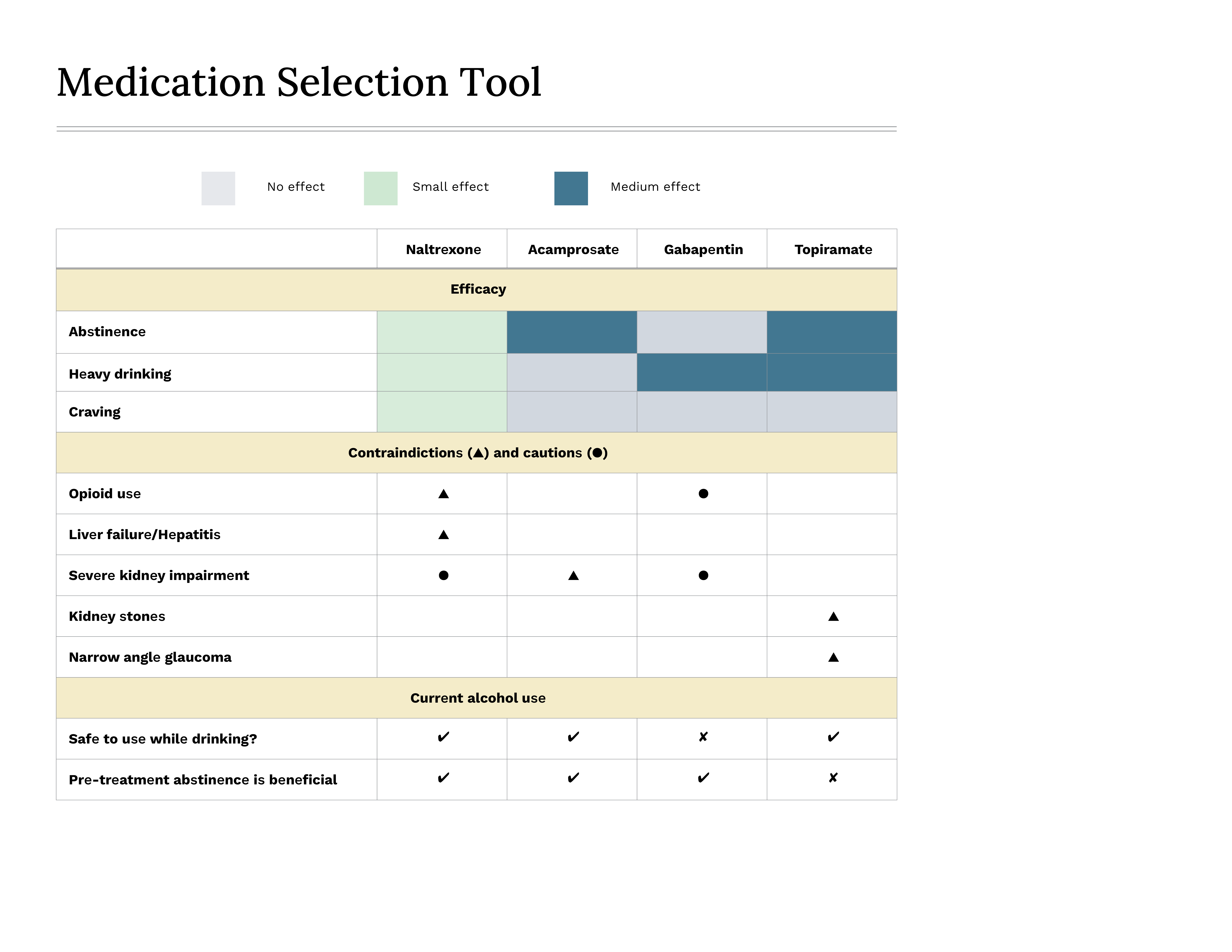Overview
All patients with moderate to severe AUD should be offered medications for long-term treatment. Medications should be prescribed for at least 6 months and then re-assessed based on effectiveness and patient experience. Medications can be continued long-term if desired.
Medications are effective for promoting abstinence or reducing heavy alcohol use. The choice of medication should be based on the patient’s goals and preferences.
Beyond alcohol consumption, medications can improve health, such as by reducing liver disease.
First-line medications: naltrexone and acamprosate
- Naltrexone is best for abstinence or reducing consumption.
- Acamprosate is best for abstinence.
Second-line medications: gabapentin and topiramate
- Use if first-line medications are contraindicated or trialled unsuccessfully.
- These are “off-label” but have shown efficacy for improving abstinence and reducing consumption.
- Gabapentin may be used to support withdrawal management and continued to support reduced drinking long-term.
Tables
The following tables compare first-line AUD pharmacotherapies and alternative pharmacotherapies.
Pharmacotherapy options for AUD
download
Drug Coverage by Province/Territory
This table shows the coverage of the 4 AUD medications and is up to date as of August 2023. Coverage details do change, so please check the formulary links below for the most current information.
Province/
Territory |
Naltrexone |
Acamprosate |
Gabapentin |
Topiramate |
|
AB
|
✔
|
—
|
✔
|
✔
|
|
BC
|
✔
|
✔
|
✔
|
✔
|
|
MB
|
✔
|
✔
|
✔
|
✔
|
|
NB
|
✔
|
✔
|
✔
|
✔**
|
|
NL
|
✔
|
✔
|
—
|
✔**
|
|
NS
|
✔
|
✔
|
✔
|
✔**
|
|
ON
|
—
|
—
|
✔
|
✔
|
|
PEI
|
—
|
—
|
✔
|
✔**
|
|
QC
|
✔
|
—
|
✔
|
✔
|
|
SK
|
—
|
—
|
✔
|
✔**
|
|
YT
|
—
|
—
|
✔
|
✔**
|
|
NT/NU
(Non-Insured
Health Benefits)
|
✔
|
✔
|
✔
|
✔
|
✔ refers to regular benefit status
— refers to Limited Use, Special Authorization or Exception Drug Status
**Topiramate Sprinkle Capsule 15mg and 25mg are covered under Limited Use, Special Authorization or Exception Drug Status
Medication Selection Tool

Download the medication selection tool here.
download
Specific populations
The safety and efficacy of medications for ongoing treatment of AUD has not been fully established in youth, older adults, pregnant or breastfeeding populations. Careful assessment of benefit and risks, fully informed patient consent, and more frequent monitoring is advised.
Youth
- Youth often benefit from psychosocial treatment and are infrequently prescribed medications.
- If medications are considered for youth, naltrexone or acamprosate are the preferred options. Small studies have shown naltrexone to be effective.
Pregnant or breastfeeding
- If the benefits of medications outweigh the risk of continued alcohol use, naltrexone, acamprosate or gabapentin can be considered on a case-by-case basis and in consultation with a perinatal substance use specialist.
- If naltrexone is being used close to the delivery date, consult with an anesthesiologist since opioids will not be as effective to manage pain for labour and delivery.
- Topiramate is contraindicated due to potential developmental defects in the fetus.
- There is limited information on these medications and their excretion into breast milk. If medications are used, infants should be monitored closely for drowsiness and low weight gain.
Older adults
- Naltrexone and acamprosate are recommended, starting at a lower dose and a slower titration than for the general population.
- If using acamprosate, test for renal function at baseline and regularly.
Other medications
The medications listed below have been studied for treating AUD but are not recommended. There are exceptions in very limited populations in which these medications could be trialled if the first- and second-line options are ineffective.
Disulfiram
- Causes a reaction with alcohol that makes the patient feel sick (e.g., sweating, headache, dyspnea, lowered blood pressure, flushing, sympathetic hyperactivity, heart palpitations, nausea and vomiting).
- Under real world conditions, patients struggle with adherence, making disulfiram ineffective. However, in supervised conditions, where a designated person supports the patient to take the medication, disulfiram is effective in promoting abstinence. For this reason, disulfiram is not recommended for the average patient.
Baclofen
- There is limited evidence that supports baclofen’s efficacy. However, it can be effective for promoting abstinence in patients who have completed withdrawal management. This can be trialled if other medications are contraindicated or have not worked.
Ondansetron
- Only small studies have shown ondansetron to be useful for AUD, in very selective groups:
- In cases where onset of AUD occurred at age 25 or younger
- Among patients with a specific allele of the serotonin transporter gene
Combined medications
- There is very little research on medication combinations. The research does not show much benefit of combining 2 medications over a single medication.
